This post may contain affiliate links.
A few days ago, I got this question from a reader via email:
Now, of course, my first thought was, “Heck Yeah! I’m Awesome!”
My next thought was, “Wait a minute… These people must not have gotten too far on the internet…”
And my third thought was, “How can I thank them for their shameless flattery?”
But as I thought about their actual question, it occurred to me that it would be pretty easy to get confused about just how much you can tow, particularly with a smaller motorhome like the one they were considering. I’m not surprised that they got different answers from different dealers either. It really can be confusing.
A couple quick disclaimers before I explain how I answered them. First, while I’ve got a fair amount of knowledge of motorhomes, and with Sprinters in particular; I’m not really a “tow” guy. I actually try to avoid towing. Next, and probably more important – I don’t actually work for a motorhome manufacturer. If there is a specific model you have questions on, you will want to verify things with that manufacturer. You can call them up, it’s OK. All the ones I’ve ever dealt with have been very eager to help customers make the right decision.
The real answer to their question depends, like a lot of motorhome related topics, on weight. I thought it would be easiest to explain this by using an actual test case. But since I gutted and rebuilt our own motorhome, it’s not a good example. So I headed down to General RV here in Utah, where I found a representative small motorhome. Here she is, a Siesta Sprinter 24 ST by Thor Motor Coach.
And, for the sake of argument, we’ll assume we want to tow the same Jeep Rubicon that my reader has, at 4720 pounds.
The first thing to know is that the Siesta Sprinter is built on a 2014 Mercedes Benz 3500 cut-away chassis. You can find the specs for this chassis here:
http://www.mbsprinterusa.com/sprinter/cab-chassis/specifications/3500-standard-roof-170-wb/14
There are three numbers here that we’re interested in. The first is the maximum towing capacity. It’s listed at 7500 pounds. Your first thought here might be “WOO HOO! We’re done!”, but there’s more to the story.
The next number to pay attention to is the Gross Vehicle Weight Rating (GVWR). It’s listed at 11,030 pounds. This number represents the maximum weight that the vehicle itself is allowed to have. So our theoretical Siesta Sprinter can’t go above the 11,030 pounds. The towed vehicle (the Jeep) doesn’t count toward this number, but the tongue weight of the trailer *does* count here. You can actually find this GVWR number on the tire pressure plate inside the driver’s door. You can also find the axle weights there if you are wanting to set your tire pressure properly.
The third number from the Mercedes Benz page to check is the Maximum Available Gross Combined Weight Rating (GCWR). This is 15,250 pounds. So EVERYTHING – the motorhome, the people in it, the towed vehicle, the water in your tanks (fresh, grey and black), the jumper cables and that ratty blanket you left in the Jeep, the burrito you had for lunch. ALL OF IT COMBINED has to weigh less than 15,250 pounds.
The next thing we want to do is have a look at the hitch. Here it is:
Pretty standard. And of course, the most important thing on the hitch is the weight rating plate. In this case, it says we can tow up to 5000 pounds. When a manufacturer tells you that the vehicle can tow 5000 pounds, this is where that comes from – the hitch rating (typically).
So, this alone would bring our 7500 pound towing capacity down to 5000 pounds. But there’s more. Next, we need to find a weight sticker that was put on by the RV manufacturer. On this model, Thor put it inside the passenger door, but on yours, it may be in a cupboard, or inside a closet. You’ve probably seen it – and hopefully you didn’t peel it off and throw it away.
This gives the Occupant and Cargo Carrying Capacity (OCCC) of the motorhome. Now, so I don’t mistype anything, here’s the definition of this, straight from the RV Safety Education Foundation:
OCCC (Occupant and Cargo Carrying Capacity) (for Motorized RVs only): This figure states the maximum allowable weight of all occupants (including the driver), plus the weight of all food, tools, full fresh water tanks, full LP-Gas tanks and personal belongings. The maximum allowable weight of passengers is based on the number of seat belted positions in the motorized RV. The regulation also states that the “tongue weight of towed trailer counts as cargo.”
On this motorhome, that number is 1178 pounds. So now, it’s time for some math. What this OCCC is telling us, is how much weight we have to play with before we tip over 11,030 pounds. We can subtract to find the weight of the empty RV.
11,030 (GVWR) – 1,178 (OCCC) = 9,852 pounds (the weight of the empty RV)
OK. Now, let’s virtually load up our RV, add on the towed vehicle, and see if we’re over weight. We need to check whether or not the weight of the whole enchilada (The RV, PLUS the towed vehicle) is greater than the GCWR, which in this case was 15,250 pounds.
- Weight of Empty RV: 9852
- Weight of Jeep: 4720
- Weight of Driver (me) 190
- Weight of Passenger 120 (If you’re a guy, you should always estimate the weight of your spouse at 120 pounds. It just works out better for everyone.)
- Full load of water 398 (for this RV, the water weight is listed on the OCCC sticker. If you have to add this in yourselves, be sure to INCLUDE the water in the water heater, like Thor did.)
Adding all those up, I get 15,280 pounds. This is greater than the 15,250 GCWR. We’re overweight.
If we were to try to hook this up and tow, we’d be getting ourselves into a dangerous situation. It doesn’t seem like a lot overweight, but remember, we STILL haven’t added in the weight of a full tank of propane (68.2 pounds), any food, any other cargo, any extra passengers or pets, and a contingency in case you have to travel with full black and/or grey tanks (up to another 398 pounds on this model ). If doing the math isn’t your thing, it’s just as easy (and more accurate) to load your RV up just as you would for a trip, and drive down to a local truck scale.
Once you start adding it all up, you see that you can pretty quickly get overweight – and I’m not just talking about towing. When you consider that this Siesta Sprinter has over 62 cubic feet of exterior storage, it wouldn’t be too hard to tip over the 1,178 pounds of cargo carrying capacity just by filling up the basement!
And speaking of that exterior storage, check out this garage-type storage compartment in the back. If I had had my bike with me, I would have tried to fit it in there! I think I need to go back and check this motorhome out in more detail. (The side-opening compartments are a nice touch too – they won’t be banging on your head!)
So, on this vehicle, Thor could, legitimately, advertise a 5000 pound towing capacity. The fine print would say “when driven by a single flyweight, who carries no water”. To their credit, I couldn’t find an advertised towing capacity from Thor. They took the high road, and just published the weights, and let you figure it out for yourself. And now that you’ve read this, hopefully you can!
So, exactly how much can you tow with a smaller motorhome? Only you can say, because only you know exactly how heavy you roll. But with a little simple addition, and a few specifications, you don’t need to be at the mercy of an RV dealer for this critical info.
I’m sure there will be lots of comments and questions on this one, so let’s hear it down in the comments!

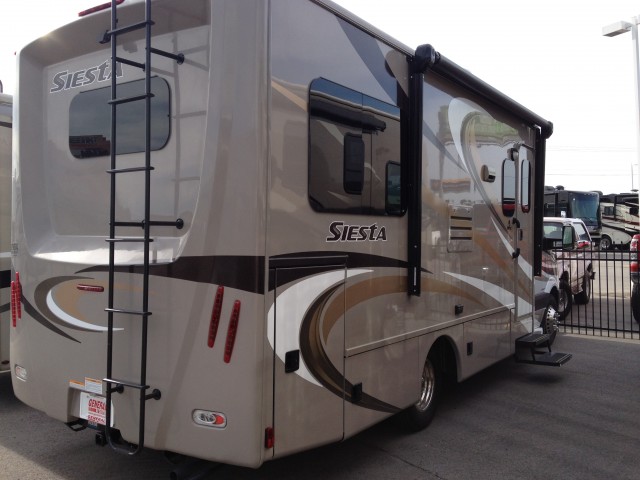
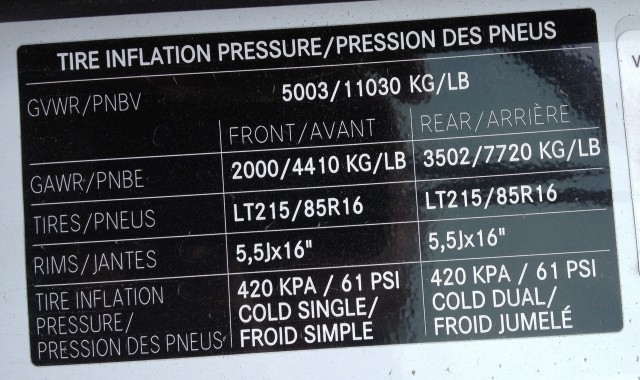
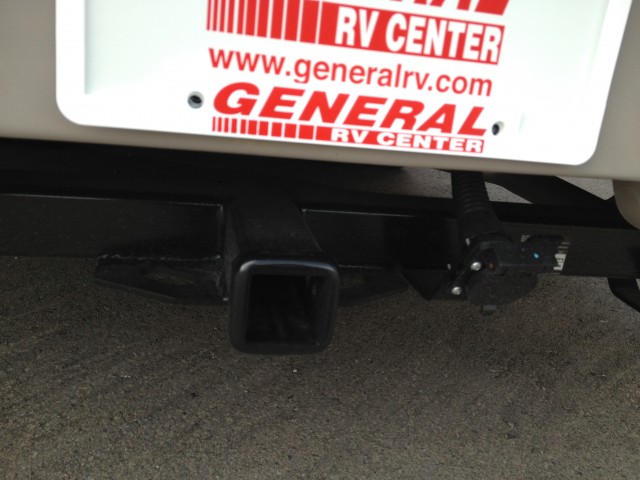
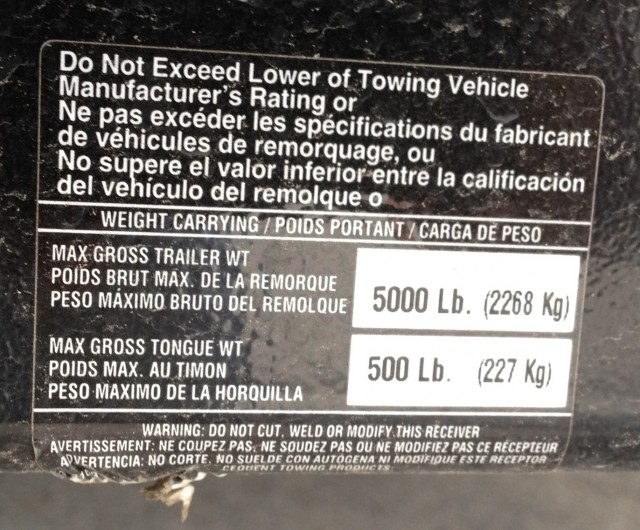
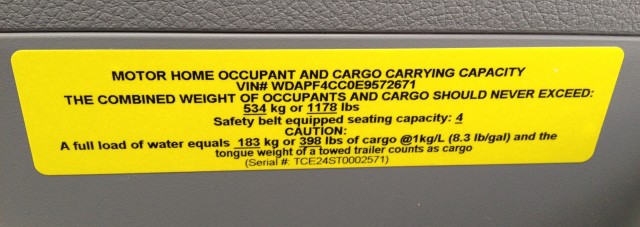
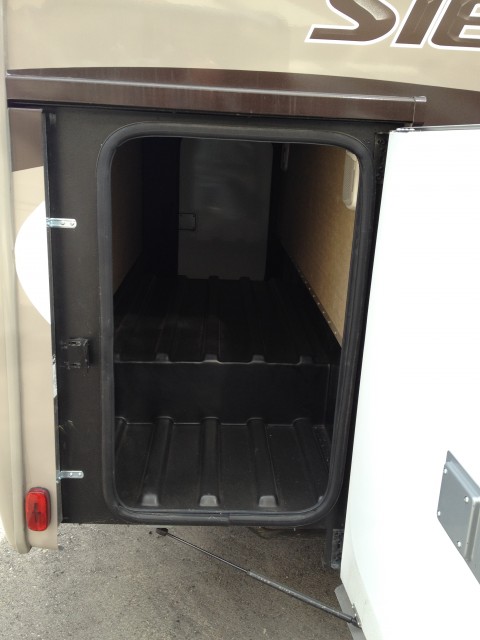










I love flat towing my Fiat 500 behind my Wiinnebago View (Sprinter 3500 cutaway). The Fiat is a great choice at only 2400 pounds. The 40+ mpg highway is nice too. This gives plenty of headroom on weight: If you are getting close on GVWR, you can then carry more by taking a few hundred pounds of gear out of the RV’s storage compartments and placing it in the Fiat. The downside is it’s not much of an offroad vehicle. However, there’s so much weight capacity left, you can do a dual hitch adapter and take along a couple of electric mountain bikes with knobby tires, depending on the weight of your bikes and rack. Ours are relatively light: 100 pounds for both bikes combined and the rack is 47 pounds.
I have an “older” Winnebago Warrior Built on a Chevy P30 frame with a 6.5 diesel motor. I have been towing a 4 horse trailer for years. I had a heavy nitch installed with a 2-5/16 ball. I do have problem maintaining speed when climbing hills but as long as I take speed into concideration.( and engine temperature) I pretty much have no problems. The P-30 ftame comes all the way to the bumper so it was easy to mount the hitch. I am currently in the market for another motor home with more H.P.
The key to tounge capabilities is the distance from the rear axel and the hitch ball!
I have the same motor home! A 26 footer. How’s the towing going? The weight limit in my manual states 3500 max pulling weight. Do you think your horse setup exceeds this number?
Allowable gross weight is not the same and COMBINED gross weight.
Gross weight of the towing vehicle is the weight of the vehicle plus people and everything else you load in there plus the tongue weight of anything you are towing. You don’t add the weight of the towed vehicle.
Uh. I think that’s what I said.
There are two weight limits. You don’t want to be over either.
GVWR (not towing) and GCWR (when towing)
Why did you deduct the OCCC number and then add weight of passengers back in this should already be a deduction
I have Tiffen wayfarer GVWR 11,030
GCWR 15,250
OCCC 687lbs
Only haul 60lbs of probe
Never fill water tank till parking
What my allowable flat vehicle weight I can tow
I weigh 241.00
Wife 130lbs
Dog 100lbs
Hitch 100lbs
No food
100lbs clothes
OCCC is Occupant and Cargo Carrying Capacity.
From what you’ve given me, the Wayfarer is a vehicle that is pretty heavily loaded.
The GVWR is 11030, with only 687 pounds of OCCC.
Sorry to break this to you, but from what you’ve told me, you’re already overweight.
60+241+130+100+100+100 = 731 which is greater than your OCCC.
Since the tongue weight of a towed vehicle also counts as cargo, you really shouldn’t tow anything.
In fact, you shouldn’t even drive it until you can get the weight of the vehicle itself below the GVWR.
Just read this and saw an error. Tongue weight is the weight being exerted down on the trailer hitch. That weight is being carried by the towing vehicles suspension. The towed vehicles weight cannot exceed the Difference between the Gross Vehicle Weight Rating (GVRW) and Gross Combined Weight Rating (GCRW). If a person is flat towing a vehicle the tongue weight will be minimal, a hundred pounds or less. Using a dolly it would be a little more, 100 to 200 pounds. Using a flat bed trailer, 4 wheels off the ground it would be higher, 9-15% of trailer weight + towed vehicle weight.
Maybe I’m being dense, but I’m not seeing where the error is.
Though in your comment, I believe there is technically an error.
You said “The towed vehicles weight cannot exceed the Difference between the Gross Vehicle Weight Rating (GVRW)(sic) and Gross Combined Weight Rating (GCRW)(sic).”
That’s not always true. If your vehicle weighs less than the GVWR (and I hope it does), then the towed vehicle could weigh more than the difference between the two.
Please do make a video!! Having always wondered about how to weigh my rig I latched onto your comment about “CAT scale”. Never heard of ’em before – but Google got me going thanks to your comment!!
Meanwhile for the other neophytes out there, this info might be helpful ’til you make your video and really explain it all to us:
– It costs $11.50 (latest price I could find in 2018)
– you can find your nearest location at CATscale.com
– Fifth Wheel St has a simple explanation page at :
http://fifthwheelst.com/weighing-guide.html
– Your video would be the BEST tho.
I’m sorry. I’m a newbie, and female, and this mechanical stuff is a blur to me. Please forgive me if this is a stupid question. Does this calculation apply the same for a hitch mounted motorcycle carrier? We are trying to figure out a way to have an alternate form of transportation without towing. Were told a lightweight motorcycle might be the way to go. I know you said you can’t be motorhome specific, but if it helps, ours is a 27 ft. Thor Vegas 25.5.
BTW, LOVE the wife is always 120lbs! I’ll be sure and pass that one on to hubby.
Thanks! Kelley
A hitch mount is not the same as a towed trailer.
A hitch mount motorcycle carrier would count as cargo weight on the vehicle itself, and would be considered part of the GVWR, not the GCWR.
So I have a Nissan Juke. Is there any class C Motorhomes I can tow this vehicle with! (It would be myself 110lbs + 2 chihuahuas
Usually the tongue weight is Max. 500 lbs You can carry a 275 lb motorcycle on a motorcycle rack carrier no problem. The motorcycle 275, and the carrier, Max. 50 lbs that’s total of 325 lbs. No problem
This is a great analysis, but I think they’re quoting the wrong weight for that Rubicon. That is quite possibly the GVWR they’re quoting.
According to this, the curb weight of 2018 Wrangler Rubicon is 3879lbs:
https://www.caranddriver.com/jeep/wrangler/specs
Correct for 2-door. My 4-door (Unlimited as it’s called) weighs 1,000lbs more stock. With steel aftermarket bumpers, lift, larger tires, body & axle protection, I’m over 5klbs.
6 cilinder Mercedes diesels advertise 188 HP with a torque of 325. Doesn’t
that figure in the towability, especially going up Mountain passes?
It does figure into the ratings, but not for you – for Mercedes.
All of that information is taken into account when they put the GVWR sticker on the driver’s side door frame. That sticker is all you need to know with regards to towing.
not sure if I’ve got this correct but the yellow sticker for OCCC states that tongue weight of towed vehicle counts as cargo, makes sense because it is directly weighing on said vehicle, but in your mathematical calculations you added total weight of towed vehicle, not tongue weight which I think throws the end result off.
Ahhh. In the calculation you’re referring to, I was working on the gCwr, not the gVwr. The GCWR is the weight of the whole rig + towed going down the road. I didn’t count the tongue weight in that calculation, because I included the full weight of the jeep. It would have been counting the tongue weight twice.
If you were working with the gVwr, then yes, you would include the tongue weight as cargo.
reading the past posts on sprinter, the new ones can now pull up to 4700lb but if your pulling a horse trailer or car trailer lets say, total load trailer and cargo 6500lb doesn’t the formula change do to the fact that the trailers have electric brakes on both axles, and then the trailer balanced out for best hitch load, the sprinter should have plenty of power to pull . I talk to a guy last year who added a larger hitch and beefed up frame a little and he pulls a enclosed trailer with a mustang in it with no problem, and with brakes on the trailer , no problem stopping.
The GCWR of the Sprinter chassis itself doesn’t change, regardless of what you add.
If you add electric brakes on the trailer – the GCWR is the same.
If you add a newer, higher capacity hitch – the GCWR is still the same.
And the GVWR (which includes tongue weight) doesn’t change either.
I don’t recommend exceeding the GCWR or GVWR in any case.
Now I am totally confused. I have 2001 Gulfstream Conquest motor home. I cannot find a tag that states “GCWR” . It has a reese hitch stating 3500lbs. The frame appears to be reinforced. I tow a small mazda pu and no problem. Want to tow 2009 GMC Sierra pick up. How do I figure it how much i can tow?
Not familiar with that motorhome. Can you find a tag that states the GVWR and Axle Weights?
Greetings! I failed math miserably period. No other way to state that. With that said, I am confused as usual with all the numbers I have read in this post. But maybe, my problem isn’t strictly the numbers but where the weight is being put.
Are we discussing here the amount of weight that can be added to a coach and the towed vehicle and not go over a total of 5,000 lbs which is the weight my 2010 31 ft gas Monaco Monarch V-10 can tow? I am actually looking for a better tow vehicle which will be heavier than the current Suzuki Jeep like thing I now have. A new Jeep Cherokee Trail Hawk weights 4,200 lbs. So I guess, this means I have an 800 lbs difference to work with no matter if most is placed in the Jeep?
Thanks for your help!
I’m afraid to answer your questions without more weights and information.
It sounds like you’re considering the capacity of your hitch, which is good, but not the whole story.
The “all-in” number, for both vehicles, that you really don’t want to exceed is the GCWR.
Beyond that, I’m hesitant to provide guidance without a complete set of ratings and weights. Good Luck!
I’m considering a LVT 24MB 2014. The OCCC on it is 899 pounds. Since the pilot and co-pilot add up to 400, I think that 500 pounds for everything else is not enough. You guys carry quite a lot of stuff, and probably about the same as I would. What is your cargo, propane, water tank, etc, weight? and thoughts.
Bruce
Well, I’ve not weighed each of those items individually, but by the time we get all our bikes, camera gear, exercise equipment, food and clothes loaded… we do tend to run a bit heavy. I think we have more than 400 pounds of gear we run with.
The MB is the heaviest of their floor plans. Another LTV model might work better for you.
I have purchased a 2017 Jayco Redhawk and was assured it would pull my boat and also 2017 chev 4×4 1500 pickup separately. When hooked up with a Blueox hitch the unit became undrivable due to uncontroable sway. The Red hawk is rated GVW at 14500; GCvw at 22500 it is 26 ft with a e450 power train. When I called Jayco main office the reply I got was the unit wasn’t designed to pull that much. According to there posted weight ratings I am well under them all. The hitch is rated at 7500 pounds. Do I need to contact the better business bureau for false advertisement? Are sway bars and such an (expensive option)?
Larger Class C motorhomes can have drivability issues when loaded up.
I don’t have any particular experience with your setup, but stabilizers, sway control, airbags, additional leaf springs… all of those are things people try to get a better handle on the situation.
Perhaps a Class C owner will chime in here?
I have a 2018 Grayhawk 30SX on an e450 chassis. I tow a Ford Explorer @ 5000lb vehicle weight with a Blue Ox hitch. I have no problem towing the car – just finished a 5500 mile trip out West. My problem is with the Ford V10 engine at elevations above 4000 ft – not enough power to get up hills!
Maybe u need air shocks or air lift on motorhome to equalize your hitch to eliminate your sway? Also weight equalize hitches are available. Need to level out your rear motorhome & towed trailer/vehicle. Thinking your tongue weight too heavy & younger too low causing sway?
I loved your comment about the weight of the passenger. The other day we were in Walmart and my wife saw a scale. She stepped on the scale and then she said “I don’t weight 130”. I looked closely and I said “Baby, that says 135”. I should’ve kept my mouth shut.
I’m sometimes able to learn from my experience… 😉
She was right then! She does not weigh 130.
And yes ,a wise man would’ve pointed out the sale on the endcap at that point.
You must always consider their attire plus shoes as well!
James, I’m new to the RV world and don’t have a clue. Purchased a 2017 Travato 59k. So assume it’s full of water, gas, beer, food, cloths, wife and dog. I’m thinking of purchasing a Haulmark Passport 4×6 enclosed trailer.with a curb weight of 660 lbs. Max payload is about 2300 lbs. Does this all sound doable with the Travato?
What does the OCCC sticker (should be yellow, probably on the passenger’s door) say? You’ll need that info to figure it out for sure.
Is there a used class C diesel that can tow a horse trailer (2,700 lbs) + horses 2,000 + gear + 500-800 lbs = 5,500 total? This assumes that the RV itself is fully loaded for travel too?
I will be the primary driver (woman) and do not want a huge RV, need space for 3 to sleep, shower & live.
There are an awful lot of class C motorhomes out there. I don’t even begin to scratch the surface there.
I do know you won’t get that kind of capacity out of anything built on the Mercedes Benz Sprinter Chassis. Just not going to happen.
But some of the “American” chassis based RVs do have greater towing capacity. Look for something built on one of those.
I’m Interested in purchasing a class c under 26ft. I want to pull a trailer which will fall under the recommended weight limits. I’ve read that a gas motor v10 will not pull as well as a diesel motor 6 cyl turbo at higher elevations. Your comments and advice would be appreciated
Don’t have any experience with a gas V-10 motorhome, so I can’t really offer an informed opinion on that one.
Perhaps another reader with some hands-on experience will chime in?
I am looking to do the exact same thing… Not sure what small C Class I need to look for … any help would be appreciated 🙂
The Sprinter ones won’t do it.
Since she specifically said diesel, I’m not certain which – if any – of the class Cs might.
Although, you can find class Cs build on American truck chassis that have incredible towing capacity. Like some versions of the Miniie Winnie – https://winnebagoind.com/products/class-c/2017/minnie-winnie/specifications.
They’re not diesel though.
James. Sorry for the above post. If I have a Unity Rv and plan on towing do I still have a tongue weight? Does that just mean the weight of the tow bar?
Hi – The best way to imagine tongue weight is this: If you put a scale under the trailer tongue (where it attaches to the vehicle), what would that scale read.
It’s always there (there’s always some weight – though I suppose it could go negative…). And yes, it’s still applicable to your RV.
Generally, it’s guesstimated at about 10% of the total towed weight if you have a trailer. If you were flat-towing, then it would be less.
James, some clarification please. If the regulation states “tongue weight of towed trailer counts as cargo, why did you use the full weight of the Jeep in your calculation?”
Excellent question! And re-reading this now, I could have explained it a little more clearly.
This hypothetical two-vehicle caravan is over weight on the G-C-WR (using the full weight of the jeep).
It’s close to being overweight on G-V-WR as well, but the original question didn’t say whether they were towing on a trailer, or flat towing (which would have very little tongue weight).
I’ll rewrite that part of the article now and see if I can make it more clear.
I am looking at a 2014 Solera MB 24r. I’m wanting to haul a 3 horse bumper bull that weighs 4500 and 2 horses at 950#’s a piece..and of course “stuff”. is this doable? TIA!
Without knowing more about the vehicle, I can’t say for sure.
But I’m going to guess that a 6500 pound trailer is not doable. Sorry.
Thank you very much! I am researching (retiring in a couple of years & considering full-timing it, or at least long-hauls). Pretty much decided on a ClassC. Don’t know how big yet, but trying to figure out how much tow car I can deal with (if I decided to – I have a 400cc Burgman scooter I will be hauling too) has been a real PITA! Yours is the first and only site I have found that actually gives me some information to work with! Cheers from Canada.
Hi Deb – Glad we could be of help!
Doesn’t remote braking ability on the towed vehicle add to the combined vehicle weight
I wouldn’t try it myself.
So what are some examples like your subaru impreza of vehicles that can be towed and are around 3000lbs?
I have a 29ft class C Tioga montara by Fleetwood motorhome.can i pull another 26 Prowler by Fleetwood pull behind camper with the camper?
Most likely not. You’d have to check the weights and run the numbers to be sure. But I wouldn’t hold my breath.
Would a Honda CRv be a suitable vehicle to flat tow behind a 29.2 ft. Thor ACE A class. I understand from researching the CRv is a towable.
up to 2014. After 2014 they can no longer be flat towed
Hi Michael – Without all the weights, I really can’t say.
Motorhome magazine publishes Dinghy Towing Guides for each year all the way back to 2000. They’d be a good source for information about towing any particular vehicle.
I understand the math you went through and typically use it when pulling a more traditional trailer with truck/SUV. Given that, it also makes me wonder if/why the same applies when flat 4 wheel towing a vehicle. It primarily has to do with axel placement. The traditional trailer has one or two axels close together midpoint acting as a pendulum for the weight. More in the front increases tongue weight – so much so that some mid-size Airstreams that have abnormally high tongue weight (25′ in particular), have people moving at least one on the propanes to the rear interior for transport. Also travel with minimal water, and dumping grey/black before journey.
Contrast that with 4 wheel pulling (not dolly or flatbed) a vehicle. Wide axels of the 4 wheels absorb the weight and seems like would be far less weight transfer to the towing vehicle compared to a trailer with similar stresses/weight increase with acceleration, hills, and braking. Even I can push a car (preferably on level ground) but wouldn’t even want to think about the same weight trailer, and if I did would take far more effort. And then it gets to hitch weight. Unlike the pendulum weight transfer of a trailer to the tow vehicle suspension, 4 wheel towing is almost like a train car hitch except both are not rigid, so essentially is the weight of the Hensley or competitor’s hitch.
Given the change in the variables between trailer towing and 4 wheel towing, is using the same math inputs (GVR etc) really valid?
Interesting thoughts, but I don’t think flat-towing invalidates the GCWR on the sticker on your chassis.
Their tongue weights might be different, but mass is mass. Your towing vehicle still has to accelerate, and more importantly STOP, all that mass.
I recommend following the GCWR and GVWR limits on your chassis, regardless of your method of towing.
I have a 2005 Gulfstream Conquest Limited, Model W6275. I can’t find how much weight I can tow in a dingy vehicle. Thank you, Ray Ralston
Well, you’ll need the OCCC sticker from Gulfstream, the tire loading info from your chassis, the weight of your proposed tow vehicle, and the weight of your motorhome with occupants and typical gear. Once you’ve got those, the calculations are pretty easy.
James, should we be looking at the curb weight of the towed vehicle when doing the math?
For a back of the napkin calculation that would be a good starting point.
But if you’re going to carry some baggage or supplies in the tow vehicle, then it might make sense to get it weighed as well, once you’ve got it loaded up.
This was my thought as well. The GVWR is the max on the vehicle your towing but not likely how much it’s going to weigh. If you do use this, you want to ensure you account for ANYTHING you have in the vehicle.
Great data and discussion and as relevant today as was yesterday. You have broken the code for “us” customers that could have been explained by the Mfg. Unfortunately Marketing continues to call the shots on degrees of transparancy.
Glad you find the article useful!
Hello,
Well this is where I am….I have a Mercedes Spinter Motor Home …I want to flat tow..could you please give me what I can purchase..As far as a tow Car?
I see many flat tow Jeep Wrangler?
Thank You
EZ
Hi Evelyn – There’s a lot of information that’s needed to provide answer, and I don’t have nearly enough information to give you one. It will depend on many things: how heavy is your motorhome, how much cargo do you typically carry, what kind of hitch do you have, etc. etc. etc. A trusted local motorhome dealer should be able to help you out.
Wish I’d found your concisely written article before I did my towing cap research…It took me weeks to figure everything out!
What is still illusive to me is the tongue weight. For your example RV, it is 500 pounds max. How do I know what that tongue weight is if I’m towing, say, 5,000#? Is it usually around 10% of Tow Cap or are there other factors involved?
Thanks for clarifying!
Usually everyone estimates the tongue weight at 10% of the trailer weight. But that’s just an estimate. The only real way to know for sure what the tongue weight of your load is would be to weight it.
To do that properly, you’d need to load up your trailer with everything you normally take (extra gas? whatver goes in there) and then get it on a scale. This article from etrailer shows three ways to measure it. https://www.etrailer.com/faq-how-to-determine-trailer-tongue-weight.aspx
When you get this weight, that number shouldn’t be greater than the tongue weight your hitch is rated for.
Hope this helps!
Lots of great information here, but confusing to try to decipher it all out. All I need is a small Class B, that can haul my 3500lb horse trailer with two horses. A combined weight of 5500lbs. So I am not even sure about the tongue weight at all… What do you recommend James? One thing I know for sure is I want to be safe. Precious cargo and all you know. Then I have all these torque numbers do figure out too. Ugh
That’s a tough one. The Class Bs that I’ve seen only come with – at most – a 5000lb hitch. You’re already over that.
And then most of the Class Bs are heavy enough on their own that you might not be able to tow anywhere near that 5000 pounds safely.
I think you’re going to need to look at something bigger than a class B. You’re going to want the margin of safety a beefier chassis will give you.
Great article, but it’s best to get your rig weighed rather than depend on the numbers given by the manufacturers. That way you have the facts not some engineer’s calculations. Nothing against engineers — I’m one myself, but few RV manufacturers actually weigh each rig they build. I do know that Advanced RV does — good on them. I have a friend that bought a new Tiffin Allegro Bus, Class A and the rear axle was under sized for the actual weight of his rig nearly empty. He got them to install a new axle with higher weight rating. Be safe — GET YOUR RIG WEIGHED!!
Agreed. Weighing your rig will always be the gold standard in these kinds of calculations. (And getting it weighed as you actually travel in it. Not empty.) Sound advice.
I wonder if everyone knows how to do this though? The CAT scales can be intimidating. Wonder if I should make a video…
Yes, I think you should definitely make a video on this topic. I believe many people are intimidated at the truck stop scales and having an idea of what the process is to get this done would give them the confidence to go do it.
Another thing to consider is to also have the vehicle you plan to tow (not just the RV with which you will tow) weighed. My own experience is that the manufacturers list a curb weight that is extremely optimistic–and usually includes NO optional equipment. Nor does it include weight of fuel–so that has to be added in at 7-8 lb per gallon! My 2012 2-door Jeep JK lists a curb weight of about 4200 lb from Jeep. However, when I weighed my modified Jeep, it actually weighed about 4700 lb–a 500 lb difference!!
This is a safety issue. By far it’s best to weigh BOTH vehicles loaded exactly the same as you will have them for your travel. In the end, these are the weights that actually matter.
Hi John –
Absolutely correct. Actual weights are to be preferred over manufacturer’s estimates 100% of the time.
And yes, you should always weigh as you intend to travel. That includes water, fuel, groceries, dogs, garbage, whatever!
James,
Thanks for this analysis. For the sake of my simple mind, am I correct in perceiving the “least” amount of towing capacity for any given vehicle to be GCWR minus GVWR (4,220 using your example)? To this I can then add back additional towing capacity to the extent I have unused or left-over OCCC? So again using your example, if I only add 1,000 pounds of stuff (OCCC weight), my actual towing capacity increases from 4,220 to 4,398 (subject, of course, to any tow hitch limitations)?
Yes, you’re correct. And that’s not a bad way to think of it. In addition to the hitch rating, you would also want to pay attention to the tongue weight, and also any maximum towing capacity for the chassis (7500 pounds for this Sprinter). Although most small motorhomes are on the heavy side, and it’s unlikely you could get anywhere near that 7500 pounds…
So, what about a full tank of diesel? Does this add to the mix?
Mike – Good question! Yes, it does. Fuel weight absolutely does count toward GVWR and GCWR. If you go to weigh your vehicle, you should always weigh it with a full tank.
The manufacturer should have considered fuel weight when they give you the OCCC, so the calculations in the article should stay the same.
You can read the definitions for all the weights here.
On that page, they call out which ones include fuel, and even give you the weight of a gallon of diesel (6.8 lbs.)
Thank you James
No problem at all!
James, just so I know what I’m looking at, I’m looking at a possible purchase of a 2015 Newmar Ventana 3636. The figures I see posted on their site are: GVWR 36,400; GCWR 46,400; UVW 26,900; NCC 9,500; and towing capacity 10,000. Reference: http://www.newmarcorp.com/motor-coaches/diesel/ventana/specifications/. The towing capacity I saw somewhere else on their site. I don’t know what UVW means or for that matter what NCC means, and their brochure doesn’t say. Do you have an idea? Can you do your math and tell me what I could carry in the vehicle and what I could tow? I don’t expect you to do this math for every non-engineering capable possible motorhome purchaser, but I think one more example (mine) would help clarify things for all of us (especially me). Personally, I am new to RVs, but from what little I do think I know, is that I trust Newmar more than other manufacturers (we won’t specifically point to Thor).
OK. Your example actually comes out pretty easy. UVW is Unladen Vehicle Weight. NCC is net Cargo (or Carrying?) Capacity.
The Max GVWR (36,400) – Unladen Vehicle Weight (26,900) = Net Cargo Capacity (9,500). Meaning, you can take along 9,500 pounds of stuff in the vehicle, and not be overweight. That seems like a lot, so you should be good.
The towing capacity is the Gross COMBINED Weight Rating, GCWR (46,400) – the Max Gross Vehicle Weight Rating (36,400) = 10,000 pounds exactly.
So, on this rig, you’re in the clear. You could load the vehicle up with 9,500 pounds of stuff and still be under weight. Then, on top of that, you could STILL tow 10,000 pounds.
That thing’s a beast! You’ll be fine. Hope this helps!
James, if your calculations are correct, and I have no reason to challenge them, then Thor is being totally dishonest in even selling this vehicle, much less allowing its vendors to mention the 5000 lb towing hitch. If you, your 120 pound partner (I pretend my wife is still the 105 pounds she was when we married), and the water puts it over the 15,250 GCWR limit. What is a buyer of this vehicle supposed to do? Use it as a lawn ornament? I have to admit that this was one of the vehicles on my short list of possible buys. If your calculations are correct some law firm should file a class action suit against Thor! I’m really pissed.
Hang on! Don’t get out the torches and pitchforks just yet!
I think you might be forgetting about the Jeep. That Jeep was pretty darn heavy.
It was me, my partner, a full load of water, PLUS the 4700 pound Jeep!
Leaving the towing aside for a moment, you have 1,178 pounds of capacity for just stuff in the motorhome. That’s enough for you, your partner, a load of water, a full load of propane, and around 400 more pounds of stuff.
And then, on top of that, you could STILL tow (GCWR) 15250 – (GVWR) 11030 = 4220 pounds.
Now sure, that’s not quite 5000, and not enough to tow the Jeep in the example, but you could still tow something like my Subaru Impreza, which comes in at around 3,000 pounds.
If you really wanted to, you *could* tow 5000 pounds with the Thor Siesta Sprinter, but you would have to forgo 780 pounds of cargo to do it.
It’s fairly common for these small class C (B+) motorhomes to come in pretty heavy on the Sprinter. I don’t think this is at all unusual.
In my opinion, Thor is being pretty open about the weights. The only thing I had to actually get to the motorhome to see was the OCCC, and that’s common in the industry.
If you still feel like something’s not on the up and up, contact me via email, and I’ll try to help you figure it out. I’m just trying to help – don’t want to get anyone in hot water.
I bet a smaller, true class B could tow more because it’s carrying less weight in the first place, right?
You’re absolutely right. A true class B starts out a lot lighter, but has the same Max GCWR. The extra capacity can be used for additional cargo, towing, or both. (Of course, in a true B, there’s less room for cargo anyway!)
I called Mercedes and they indicated that the Leisure Travel Van’s can tow 7,000 lbs but that they advertise only 5,000 in the brochures to allow for other items such as water, etc.
I think the 5000 pounds may be the rating of the hitch receiver that is installed. If you have an LTV, or are considering purchasing one, you’ll want to double check the towing hardware to make sure it’s rated for what you need.